Abstract
A study was performed to determine the effect of parenteral treatment with four broad-spectrum cephalosporins (cefoperazone, ceftriaxone, ceftazidime, and cefepime) on the number of aerobic gram-negative rods and on the outgrowth of Candida albicans and a multiresistant strain of Citrobacter freundii in the feces of mice. The estimated fractions of a parenteral dose that were excreted into the gastrointestinal tract were 0.37 for cefoperazone, 0.11 for ceftriaxone, 0.03 for ceftazidime, and 0.002 for cefepime. All four cephalosporins significantly decreased the number of aerobic gram-negative rods in the feces, and virtually all gram-negative rods were eliminated at high doses of cefoperazone, ceftazidime, and ceftriaxone. Furthermore, at high doses these three compounds led to a significant increase of the outgrowth of resistant Citrobacter freundii. The outgrowth of Candida albicans was increased at high doses of cefoperazone and ceftriaxone, whereas ceftazidime and cefepime did not have this effect. The most profound changes in the gastrointestinal ecology were observed during treatment with high doses of cefoperazone. The results suggest that the colonization resistance of the gastrointestinal tract can be substantially decreased by parenteral treatment with cefoperazone and, to a lesser extent, with ceftriaxone and ceftazidime.
Full text
PDF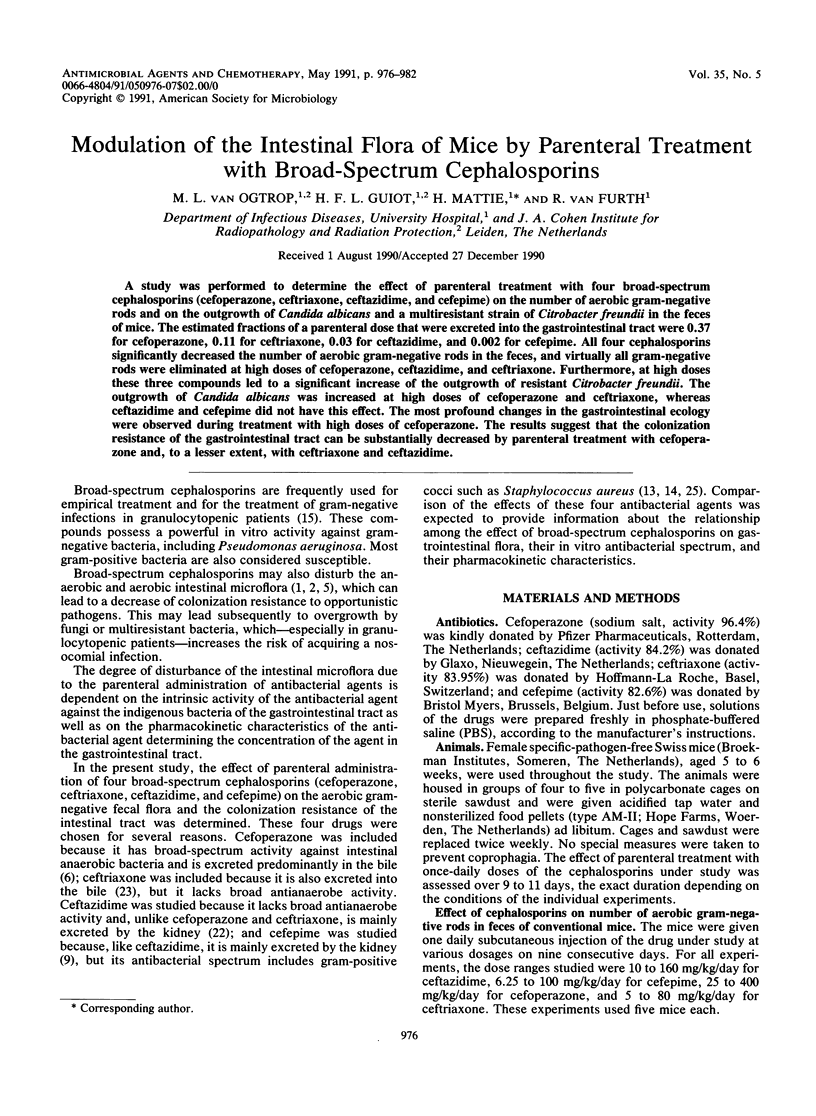
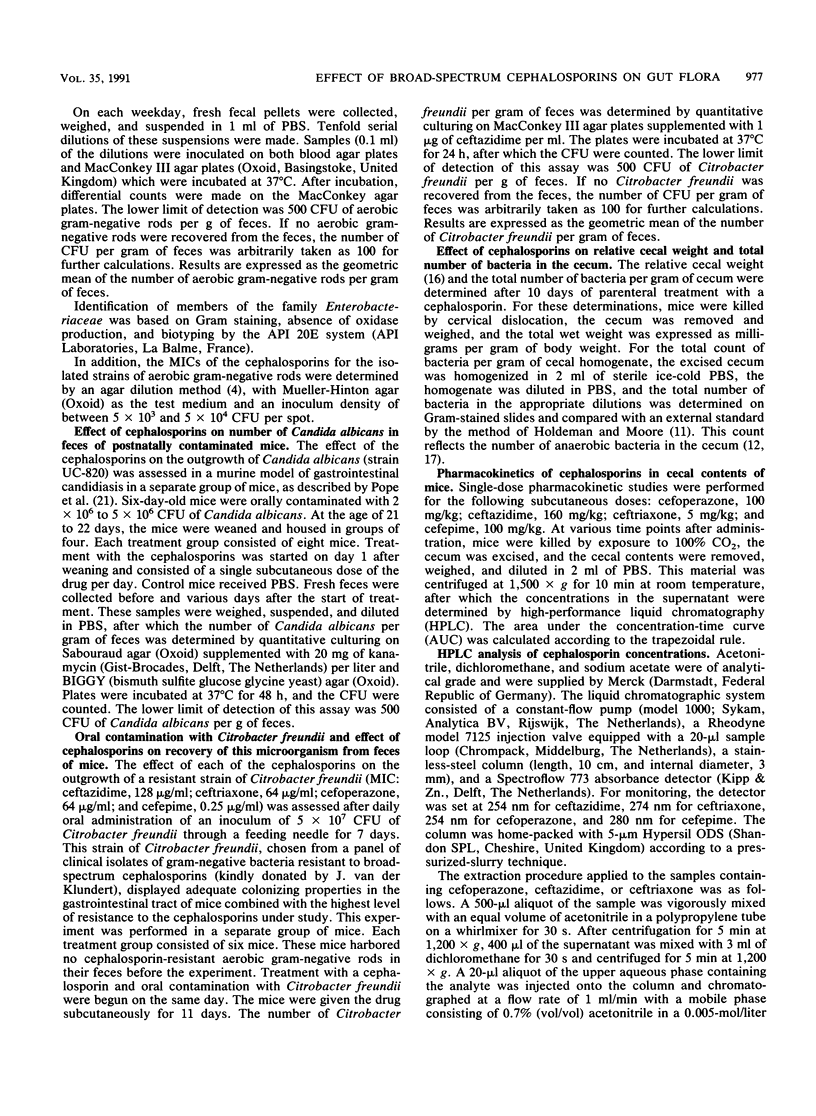
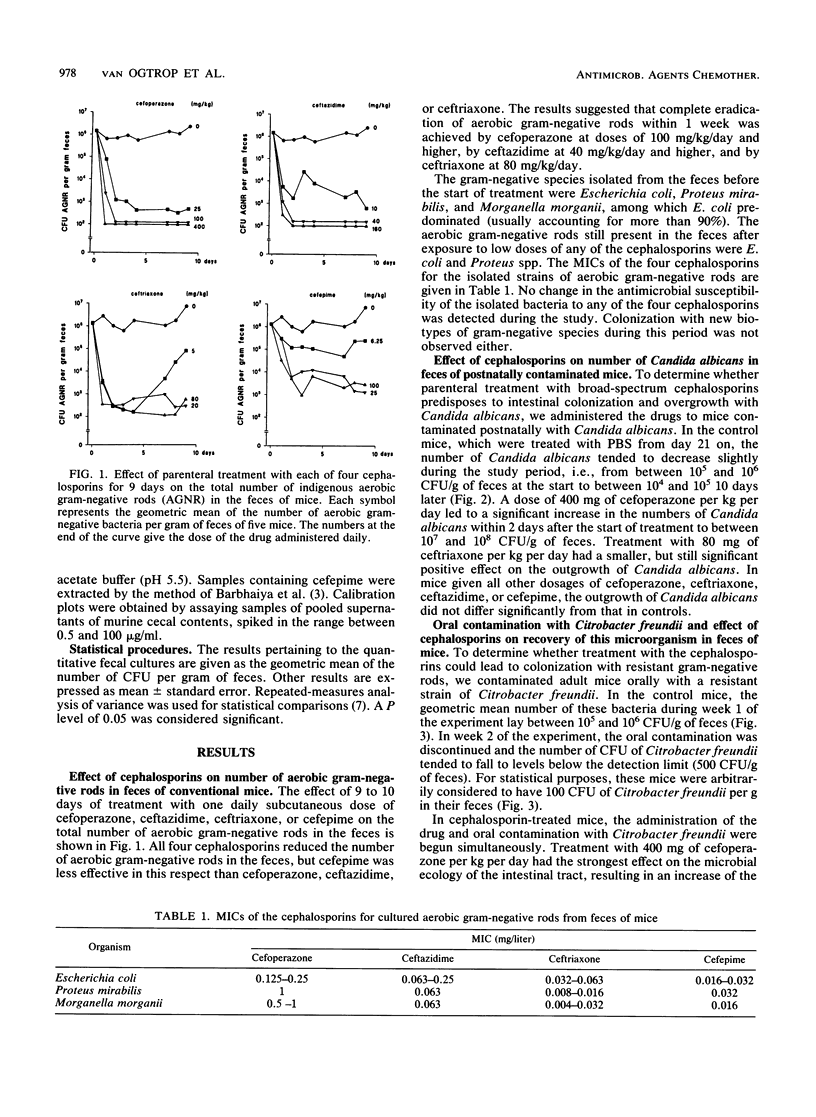
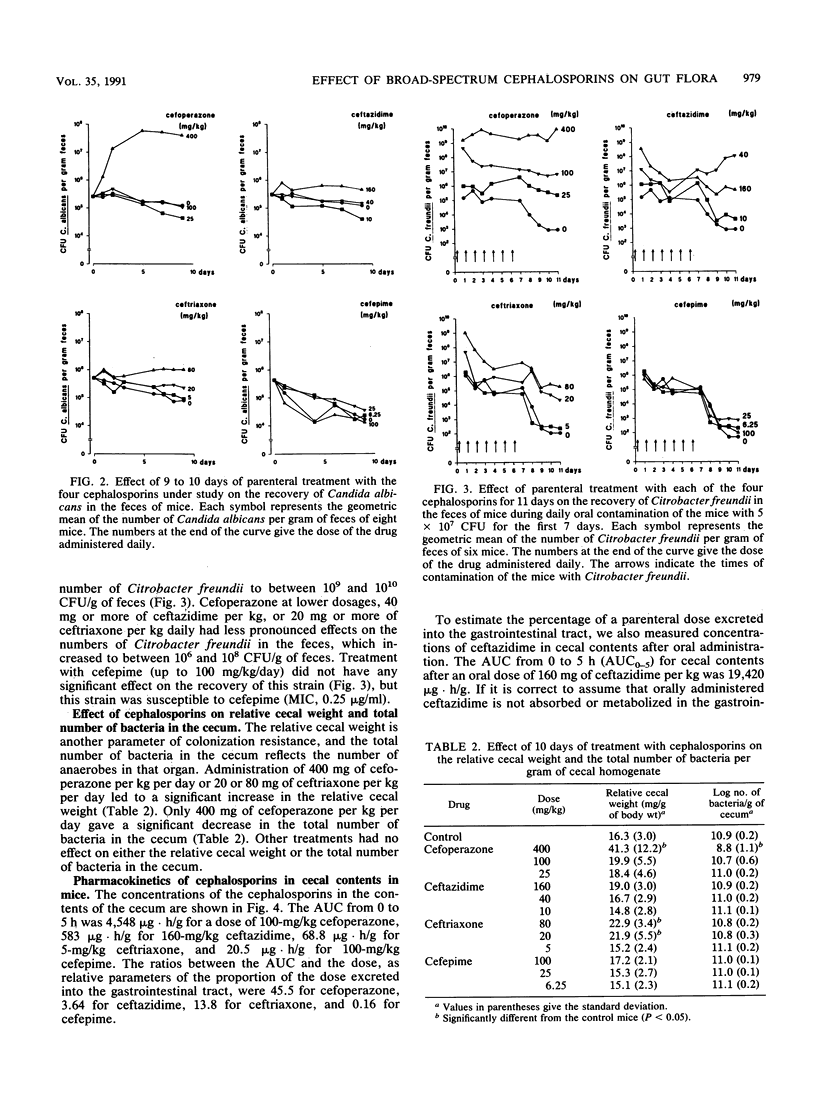
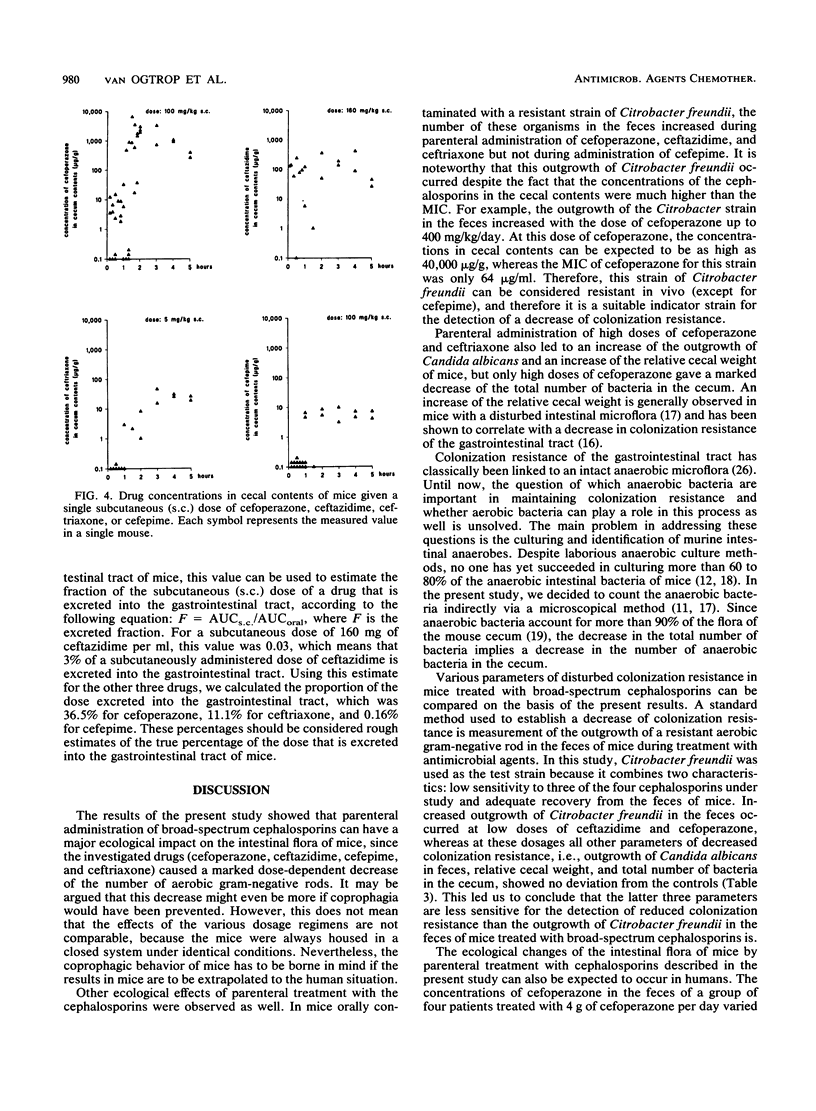
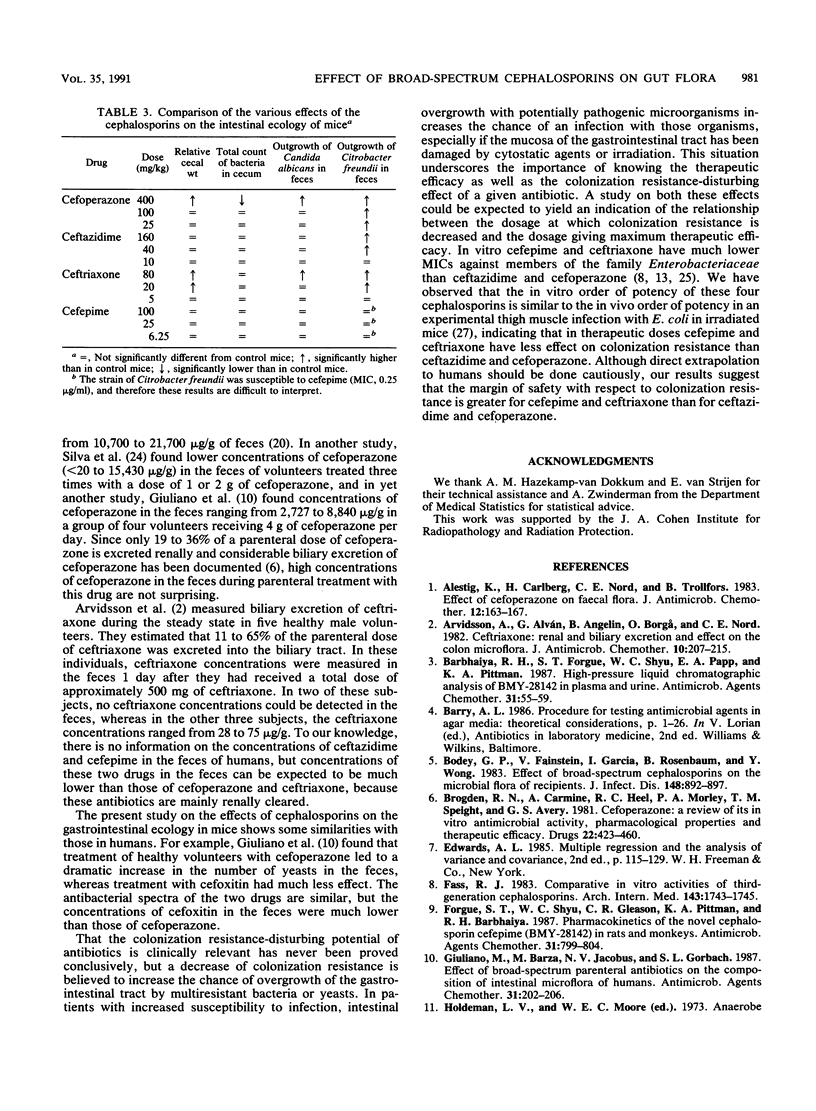
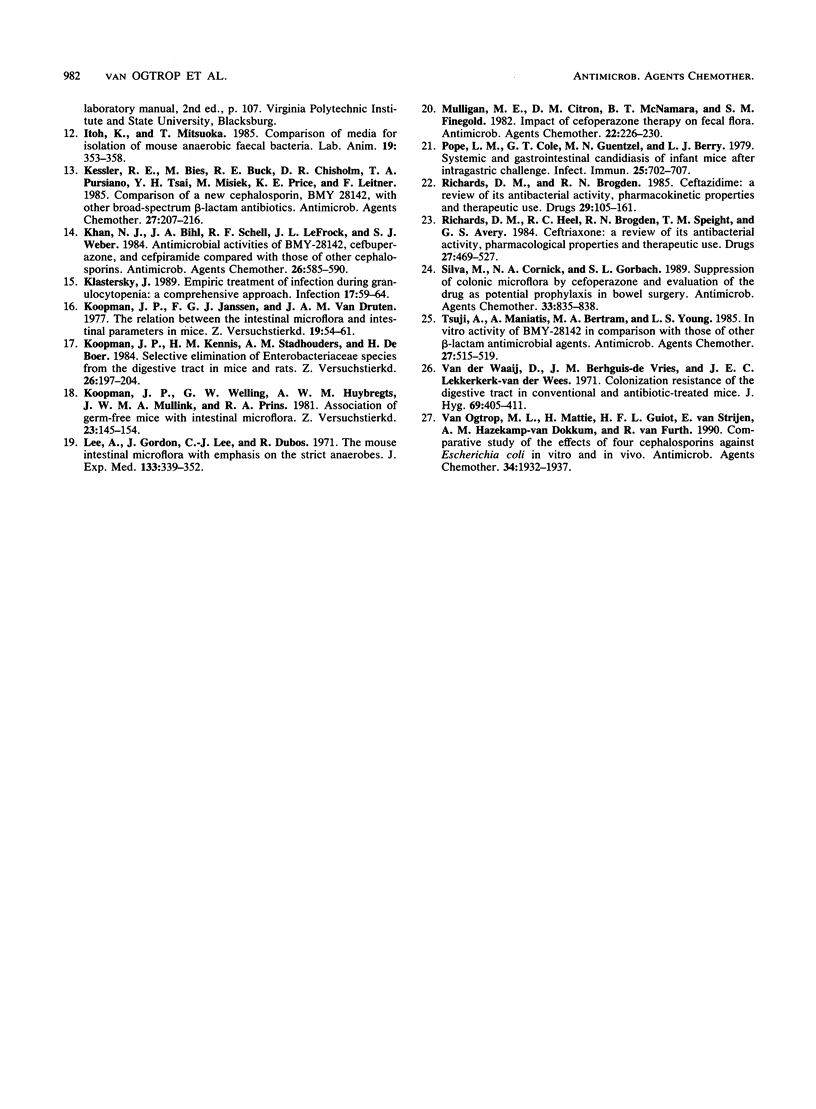
Selected References
These references are in PubMed. This may not be the complete list of references from this article.
- Alestig K., Carlberg H., Nord C. E., Trollfors B. Effect of cefoperazone on faecal flora. J Antimicrob Chemother. 1983 Aug;12(2):163–167. doi: 10.1093/jac/12.2.163. [DOI] [PubMed] [Google Scholar]
- Arvidsson A., Alván G., Angelin B., Borgå O., Nord C. E. Ceftriaxone: renal and biliary excretion and effect on the colon microflora. J Antimicrob Chemother. 1982 Sep;10(3):207–215. doi: 10.1093/jac/10.3.207. [DOI] [PubMed] [Google Scholar]
- Barbhaiya R. H., Forgue S. T., Shyu W. C., Papp E. A., Pittman K. A. High-pressure liquid chromatographic analysis of BMY-28142 in plasma and urine. Antimicrob Agents Chemother. 1987 Jan;31(1):55–59. doi: 10.1128/aac.31.1.55. [DOI] [PMC free article] [PubMed] [Google Scholar]
- Bodey G. P., Fainstein V., Garcia I., Rosenbaum B., Wong Y. Effect of broad-spectrum cephalosporins on the microbial flora of recipients. J Infect Dis. 1983 Nov;148(5):892–897. doi: 10.1093/infdis/148.5.892. [DOI] [PubMed] [Google Scholar]
- Brogden R. N., Carmine A., Heel R. C., Morley P. A., Speight T. M., Avery G. S. Cefoperazone: A review of its in vitro antimicrobial activity, pharmacological properties and therapeutic efficacy. Drugs. 1981 Dec;22(6):423–460. doi: 10.2165/00003495-198122060-00002. [DOI] [PubMed] [Google Scholar]
- Fass R. J. Comparative in vitro activities of third-generation cephalosporins. Arch Intern Med. 1983 Sep;143(9):1743–1745. [PubMed] [Google Scholar]
- Forgue S. T., Shyu W. C., Gleason C. R., Pittman K. A., Barbhaiya R. H. Pharmacokinetics of the novel cephalosporin cefepime (BMY-28142) in rats and monkeys. Antimicrob Agents Chemother. 1987 May;31(5):799–804. doi: 10.1128/aac.31.5.799. [DOI] [PMC free article] [PubMed] [Google Scholar]
- Giuliano M., Barza M., Jacobus N. V., Gorbach S. L. Effect of broad-spectrum parenteral antibiotics on composition of intestinal microflora of humans. Antimicrob Agents Chemother. 1987 Feb;31(2):202–206. doi: 10.1128/aac.31.2.202. [DOI] [PMC free article] [PubMed] [Google Scholar]
- Itoh K., Mitsuoka T. Comparison of media for isolation of mouse anaerobic faecal bacteria. Lab Anim. 1985 Oct;19(4):353–358. doi: 10.1258/002367785780887464. [DOI] [PubMed] [Google Scholar]
- Kessler R. E., Bies M., Buck R. E., Chisholm D. R., Pursiano T. A., Tsai Y. H., Misiek M., Price K. E., Leitner F. Comparison of a new cephalosporin, BMY 28142, with other broad-spectrum beta-lactam antibiotics. Antimicrob Agents Chemother. 1985 Feb;27(2):207–216. doi: 10.1128/aac.27.2.207. [DOI] [PMC free article] [PubMed] [Google Scholar]
- Khan N. J., Bihl J. A., Schell R. F., LeFrock J. L., Weber S. J. Antimicrobial activities of BMY-28142, cefbuperazone, and cefpiramide compared with those of other cephalosporins. Antimicrob Agents Chemother. 1984 Oct;26(4):585–590. doi: 10.1128/aac.26.4.585. [DOI] [PMC free article] [PubMed] [Google Scholar]
- Klastersky J. Empiric treatment of infection during granulocytopenia: a comprehensive approach. Infection. 1989 Mar-Apr;17(2):59–64. doi: 10.1007/BF01646877. [DOI] [PubMed] [Google Scholar]
- Koopman J. P., Janssen F. G., van Druten J. A. The relation between the intestinal microflora and intestinal parameters in mice. Z Versuchstierkd. 1977;19(1-2):54–61. [PubMed] [Google Scholar]
- Koopman J. P., Kennis H. M., Stadhouders A. M., de Boer H. Selective elimination of Enterobacteriaceae species from the digestive tract in mice and rats. Z Versuchstierkd. 1984;26(5):197–204. [PubMed] [Google Scholar]
- Koopman J. P., Welling G. W., Huybregts A. W., Mullink J. W., Prins R. A. Association of germ-free mice with intestinal microflora. Z Versuchstierkd. 1981;23(3):145–154. [PubMed] [Google Scholar]
- Lee A., Gordon J., Lee C. J., Dubos R. The mouse intestinal microflora with emphasis on the strict anaerobes. J Exp Med. 1971 Feb 1;133(2):339–352. doi: 10.1084/jem.133.2.339. [DOI] [PMC free article] [PubMed] [Google Scholar]
- Mulligan M. E., Citron D. M., McNamara B. T., Finegold S. M. Impact of cefoperazone therapy on fecal flora. Antimicrob Agents Chemother. 1982 Aug;22(2):226–230. doi: 10.1128/aac.22.2.226. [DOI] [PMC free article] [PubMed] [Google Scholar]
- Pope L. M., Cole G. T., Guentzel M. N., Berry L. J. Systemic and gastrointestinal candidiasis of infant mice after intragastric challenge. Infect Immun. 1979 Aug;25(2):702–707. doi: 10.1128/iai.25.2.702-707.1979. [DOI] [PMC free article] [PubMed] [Google Scholar]
- Richards D. M., Brogden R. N. Ceftazidime. A review of its antibacterial activity, pharmacokinetic properties and therapeutic use. Drugs. 1985 Feb;29(2):105–161. doi: 10.2165/00003495-198529020-00002. [DOI] [PubMed] [Google Scholar]
- Richards D. M., Heel R. C., Brogden R. N., Speight T. M., Avery G. S. Ceftriaxone. A review of its antibacterial activity, pharmacological properties and therapeutic use. Drugs. 1984 Jun;27(6):469–527. doi: 10.2165/00003495-198427060-00001. [DOI] [PubMed] [Google Scholar]
- Silva M., Cornick N. A., Gorbach S. L. Suppression of colonic microflora by cefoperazone and evaluation of the drug as potential prophylaxis in bowel surgery. Antimicrob Agents Chemother. 1989 Jun;33(6):835–838. doi: 10.1128/aac.33.6.835. [DOI] [PMC free article] [PubMed] [Google Scholar]
- Tsuji A., Maniatis A., Bertram M. A., Young L. S. In vitro activity of BMY-28142 in comparison with those of other beta-lactam antimicrobial agents. Antimicrob Agents Chemother. 1985 Apr;27(4):515–519. doi: 10.1128/aac.27.4.515. [DOI] [PMC free article] [PubMed] [Google Scholar]
- van Ogtrop M. L., Mattie H., Guiot H. F., van Strijen E., Hazekamp-van Dokkum A. M., van Furth R. Comparative study of the effects of four cephalosporins against Escherichia coli in vitro and in vivo. Antimicrob Agents Chemother. 1990 Oct;34(10):1932–1937. doi: 10.1128/aac.34.10.1932. [DOI] [PMC free article] [PubMed] [Google Scholar]
- van der Waaij D., Berghuis-de Vries J. M., Lekkerkerk Lekkerkerk-v Colonization resistance of the digestive tract in conventional and antibiotic-treated mice. J Hyg (Lond) 1971 Sep;69(3):405–411. doi: 10.1017/s0022172400021653. [DOI] [PMC free article] [PubMed] [Google Scholar]


